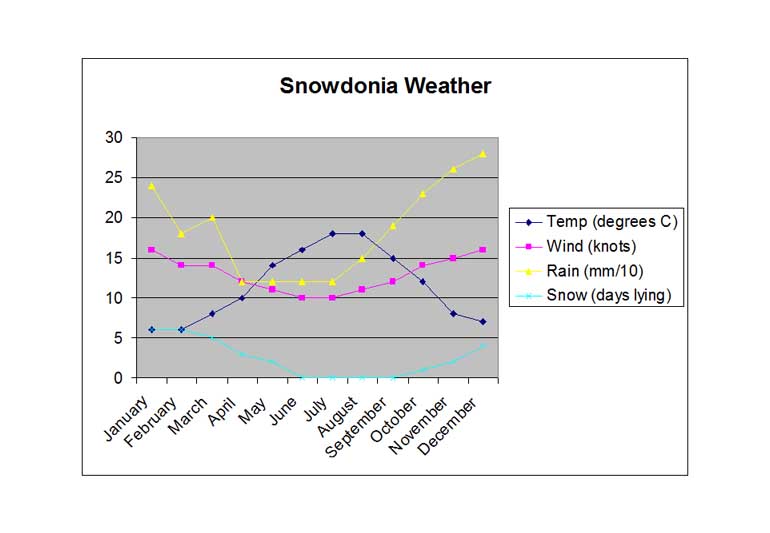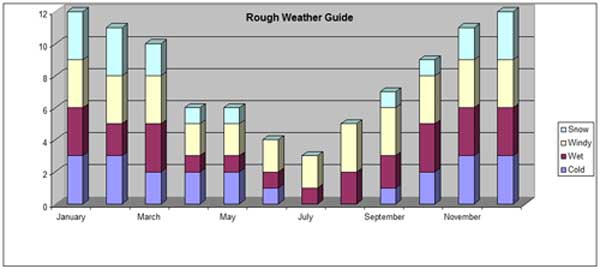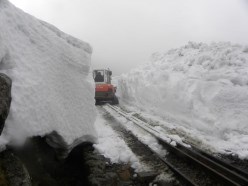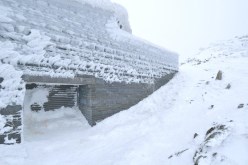

Join us on
Please visit the Sitemap to see the full range of information on this site
MountainWalk.co.uk is produced by Trish Haill Associates Copyright
Have you climbed Ben Nevis, Snowdon or Scafell Pike? Or taken part in the Three Peaks Challenge? Or have a special walk you'd like to share? We'd love to here from you! Join us on Facebook or Send us an email.
A Guide to Snowdon Weather
Although it would be impossible to predict in advance what the weather on Mount Snowdon will be like for any particular day, this page should give you some information about how best to plan for your walk.
Temperatures at higher levels are much cooler. For every 100 metres that you climb, the temperature will drop by about 0.5 degrees centigrade. The mean temperature at the summit is only around 5 degrees, so if you plan to climb in a T-Shirt and shorts you will feel quite cold at the top. You are also more likely to experience rain - Snowdon gets about 3 metres of rain per year - and you may well find yourself climbing through thick cloud. The summit gets only 1200 hours of sunshine per year, as opposed to 1700 on the south west coast of Wales.
When are the Snowdon weather conditions the best for hiking?
Rainfall
A map of the average annual rainfall in Snowdonia correlates to a topographical map. In other words, the lower you are the less rainfall, the higher you are the most. Autumn and winter sees most of the more persistent rainfall on the mountain. Summer rain is more likely to take the form of showers or thunderstorms. The months from late October to January are noticeably wetter than the months February to September. Late spring and early summer are likely to be the driest times.
Temperature
The weather at Mount Snowdon is warmest in July, with January, February and early March being the coldest months.
Wind
Wales is one of the windiest parts of the UK which will be felt particularly from November to February where speeds and gusts are the strongest. Even in summer wind can be a problem - in August 2012 a woman had to be airlifted from the Llanberis path having lost her footing and fallen over due to a strong gust. Gales are more frequent during the winter months, and the strongest winds will be on the summit.
If the weather forecast for Snowdon predicts strong winds it is a good idea to pick a different day for your walk.
Snowy weather on Mount Snowdon
Snow conditions are common between October to early June. Walking and hiking on the mountain needs extra caution and care when snow is lying on the ground- there are no easy ways to climb up or descend, as paths can be slippery and dangerous.
On average snow can be falling for 40 days per year, and can be lying on the ground for 30 days. The strong winds can cause extensive drifting on higher ground. Only from July to September can you be fairly certain that you will not experience snowy weather on Snowdon.
So what does the Mount Snowdon weather pattern look like?
Although exact figures for the top of Snowdon are not readily available, the graph below shows the conditions that can be expected at the 300m line - the Snowdon summit is 700 metres above this, so temperatures will be around 4 degrees cooler, rainfall higher, more snow and windier. But the graph is produced to show what times of the year you may prefer to climb.
The temperature is shown in centigrade, the wind speed in knots, the amounts of rain (in millimetres divided by 10 (e.g. 25 would equal 250 mm), and the number of days in that month where snow is likely to be lying.
Although exact figures for the top of Snowdon are not readily available, the graph below shows the conditions that can be expected at the 300m line - the Snowdon summit is 700 metres above this, so temperatures will be around 4 degrees cooler, rainfall higher, more snow and windier. But the graph is produced to show what times of the year you may prefer to climb.
The temperature is shown in centigrade, the wind speed in knots, the amounts of rain (in millimetres divided by 10 (e.g. 25 would equal 250 mm), and the number of days in that month where snow is likely to be lying.
Or to look at it another way see our Rough Weather Guide below - the bigger the colour block the more likely you are to experience that weather condition on the summit of Ben Nevis. Making June, July and August the best months for your hike up Mount Snowdon.

Importance of Knowing the Snowdon Weather Conditions
According to Mountain Rescue a large number of rescues are directly related to people not being properly prepared for the weather conditions they might experience. Heavy rain is common, as are strong winds and thick mist. Walkers who have planned to walk on a particular day plough on regardless when they should make tracks and return down the mountain.
If you plan to walk on a particular day, make sure you check the weather conditions first, and be prepared for the conditions forecast. If you know you might be climbing into cloud make sure you take a map, compass and preferably a GPS with you. If itís going to be wet, at the very least take a waterproof.
How can I check the Snowdon Weather Forecast?
In general
The Met Office has special pages for the weather forecasts for the major mountains in the UK. Click for the Snowdon Forecast.
Mountain Weather Information Service
10 day forecast for Snowdon (but please check other forecasts nearer to the day)
In the locality
In 1993 the Snowdon Weather Station was installed on the summit - it is the only such station in the UK not powered by mains electricity. Near real time information about the weather conditions at the summit is displayed on a monitor is an alcove on the National Park Authorityís buildings at the foot of the Pyg Track. The same information is displayed in the Electric Mountain Centre in Llanberis.
What Snow Conditions on Snowdon can look like


March and early April saw extremely heavy snowfall on Snowdon. Walkers were warned NOT to attempt to climb the mountain at all, and even experienced locals were having difficulty achieving the summit.
The top picture left shows the summit buildings under the snow drifts. The bottom picture shows attempts to dig out the railway line which was under 10 foot of snow.
Roads in the area were also under deep snow and therefore closed.
Although the average pattern of weather can be a good guide to when you should plan your walk, exceptional conditions can and do arise. Thus the importance of checking the local conditions before finalising your plans.
The top picture left shows the summit buildings under the snow drifts. The bottom picture shows attempts to dig out the railway line which was under 10 foot of snow.
Roads in the area were also under deep snow and therefore closed.
Although the average pattern of weather can be a good guide to when you should plan your walk, exceptional conditions can and do arise. Thus the importance of checking the local conditions before finalising your plans.
Pictures courtesy of Snowdon Mountain Railway
Other pages you might like:
Walking Up Mount Snowdon
How to get to Snowdon and Where to Stay
Snowdon Facts and History
Snowdon Weather
Walking Equipment
Fitness Required
Holidays in Snowdonia
Mining on Snowdon
Before starting on any route you should always check weather for Snowdon and make the decision whether it is the right day for you to go up. The weather at Snowdon summit will be very different from that at sea level or from where you are staying, and can also change rapidly during the course of the day.
